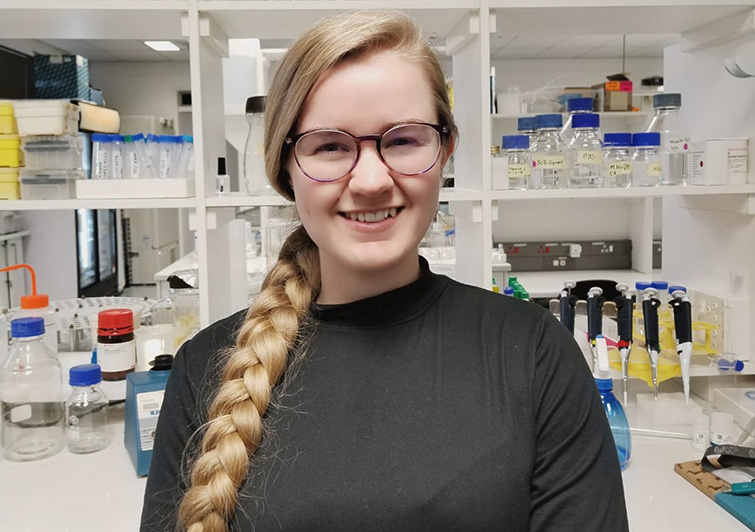24 July 2023
|
Story André Damons
|
Photo Supplied
 Tyla Baker, a postgraduate student in the Department of Microbiology and Biochemistry at the University of the Free State (UFS).
Tyla Baker, a postgraduate student in the Department of Microbiology and Biochemistry at the University of the Free State (UFS).
Yeast and other filamentous fungi, which pose a great risk to the health of immune-compromised or suppressed individuals, can be found in various drinking water sources such as ground, spring, surface, and tap water. These opportunistic pathogens may cause severe to fatal infections and can range from superficial to bloodstream or systemic infections.
This is according to Tyla Baker, a postgraduate student in the Department of Microbiology and Biochemistry at the University of the Free State (UFS). She is studying for her MSc degree in Microbiology under the supervision Prof Carlien Pohl-Albertyn, National Research Forum (NRF) SARChI Research Chair in Pathogenic Yeasts. Prof Jacobus Albertyn and Dr Jolly Musoke are her co-supervisors.
Baker says the fungi in the water highlights that current water treatment processes are not efficient in their removal from water destined for household use. “These infections may not be harmful to people with healthy immune systems, but do pose a great risk to the health of immune-compromised or suppressed individuals.
Definite possibility to contract fungal infections from polluted water
“As the number of people with immune systems that are less functional (e.g. premature babies, elderly persons, people with cancer, diabetes or other serious diseases, HIV+ persons, transplant patients) increases, the number of people at risk of fungal infection also increases,” says Baker.
According to Baker, a previous study done in Brazil has identified yeast in bottled mineral water as well as municipally supplied tap water. The potential risk to contract fungal infections from polluted water sources is a definite possibility but more research is required to fully understand and determine the level of risk and the extent of its effects, she says. In the context of Mangaung, it is a concern that untreated water from sewage works as well as other sewage often leaks into the environment (as evidenced by numerous recent articles in local newspapers). These waters are potential carriers of large numbers of pathogens (including pathogenic yeasts/fungi) that may increase the risk to people coming into contact with it.
Baker says there is a good chance people are consuming these kinds of micro-organisms daily, considering that yeast and other filamentous fungi can also form biofilms inside pipes and spread as the impact of water flow dislodges these cells. “People will not even be aware that they are consuming these micro-organisms, some fungi are considered nuisance microbes and may cause a change in the smell and taste of water which may act as an indicator that the water is contaminated, but tests would be needed to confirm this,” she says.
The effects of consuming these fungi are still a grey area of research since the full extent of the consumption of yeast is still unknown, but there are studies being conducted to elucidate the full impact of this occurrence, says Baker. The risk depends on the immune status of the person, the specific species of yeast/fungus ingested, and the number of cells/spores ingested.
Culture-dependent and independent methods
“It is important to know that many pathogenic yeasts and other fungi are opportunistic pathogens, meaning they infect individuals whose immune systems are compromised due to various reasons such as illness (HIV/AIDS, cancer, TB etc.), undergoing organ transplants or even something as simple as using antimicrobial agents such as antibiotics. “Taking this into account, along with the HIV/AIDS statistics in South Africa, which has a prevalence rate of 13,7% with approximately 8,2 million people in 2021 living with HIV, these individuals are more susceptible to infection by these opportunistic pathogens. Some of these pathogenic yeasts are also multidrug resistant or show resistance to readily available antifungals, such as fluconazole, which hinders the ability of healthcare professionals to efficiently treat infections to avoid fatal/severe outcomes,” explains Baker.
For her studies, she will be testing for fungi in water by using a combination of culture-dependent and independent methods to try and identify yeast present in wastewater. Baker says culture-dependent techniques will include culturing (growing) yeast on an appropriate medium while culture-independent techniques will include more intricate molecular work in the form of a multiplex PCR (polymerase chain reaction) which will enable her to identify an array of pathogenic yeasts present in samples.
According to Baker, people can stay safe by boiling water before drinking it, although temperatures above 100°C are required to kill most harmful microbes. Regular cleaning of shower heads and faucets help to prevent build-up which may act as a surface to which fungi will attach to and grow. Another way to stay safe is to maintain and regularly inspect water filters for damage and avoid contact with untreated sewage.